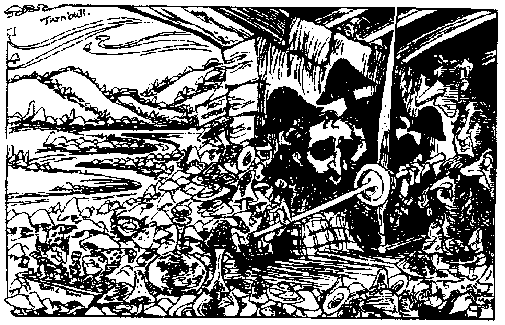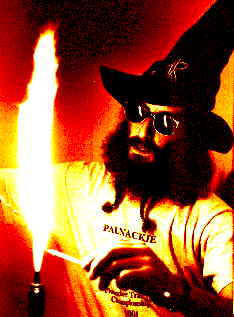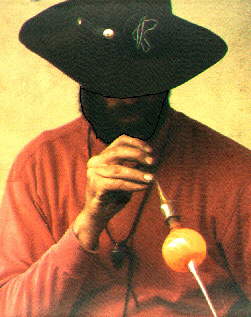as well as eating them"
For anybody who has wearied of other people's stories of their
dry rot, a man to meet is Ed Iglehart. He has scores of
mushrooms inside his house as well as outside, but they are all
happy mushrooms.
Of the several ways there are with mushrooms from glazing them
with cheese or stuffing with Brazil nuts, Ed Iglehart likes his
plain fried. He also blows his own.
more
*
His glass toadstools are a unique and strange success of the
craft industry. How much they are cherished seems very odd
indeed. A love of mushrooms in the house is hard to explain in a
soggy climate. Yet a plague of enthusiasm for his jaunty and
fragile fungi is strongest in Scotland.
Even museums which have the darkest of fears about dampness buy
his little umbrellas. Collectors in their houses have worshipped
positions for them on mantelpieces. Yet the thought of anything
else going mushroomy in other parts of the place is as much fun
to contemplate as a double mortgage.
more
*
*
*
Ed Iglehart, a long (6ft. 5in.), lean, and bearded American, who
likes to talk, is not short of several explanations for the
fascination of fungi.
"Toadstools," he says, "may be seen as a manifestation of things
from another world. They are shadows on the walls of our cave."
He goes on: "Every so often as nature carries on continuously
cycling the materials of life, up pops a mushroom as a reminder
that there is more to life than takes place on the surface.
"Oh, heck," he says, "mushrooms are an excellent excuse for a
walk in the fields."
more
*
*
Ed Iglehart lives in a former chicken farm beside where the Urr
Water twists and turns in a crazy way through the sweet mud of
its riverbed to the Solway. His wife has some Soay sheep. A cat
and two dogs about the place were arguing over a rabbit.

|
His workshop is a thick-walled stone barn, with two high windows. Since the old granary is built into a hillside it all the year round has a room temperature of an empty igloo. more * |
Ed Iglehart, 48 (in 1989), is a research chemist, a product of the
universities of Florida and New York. He once lay off work to go
and see some of the world. When he returned it was hard to find
a new start. "There weren't jobs for chemists who liked to chuck
up their jobs," he says.
He turned to his hobby of blowing glass, selling his vases and
bottles to shops and hawking them on the streets of New York.
Mushrooms were a Scottish growth.
Eighteen years ago he settled at Palnackie, Kirkcudbrightshire.
Ed Iglehart didn't so much find Scotland as the bankrupt chicken
farm found him. And he found fungi. In the fields and woods
around Palnackie he reckons he has unearthed 30 kinds of
mushrooms to eat. more
*
He was not that sure about them at first. "Like most products of
the supermarket society, I distrusted things picked up in the
woods," he says. "After all, toadstools can be poisonous, but
one of the reasons we came here was a part of the extended dream
of the '60s - to live the good life. We were going to eat
rabbits we had caught and, well, mushrooms.
"Now when I return from my meanderings in the woods,
alarm spreads across my wife's face as
I present new specimens for the
table."
more
*
*
*
What came out of his mouth in glass started to take the shape of
what he had learned to eat. He was experimenting with blowing
clear surfaces to be seen through other clear surfaces when, lo,
it turned out to be a mushroom. And other mushrooms. His art is
what he has swallowed. Ed Iglehart concedes: "I make them, yes,
because I like mushrooms."
His come in all sizes, coloured in various ways by using oxides.
At full stretch, even talking all the while to sightseers, he can
create in six hours of torch time, as many as forty, none of them
the same. Some Palnackie glass comes out droopy. Other
umbrellas look as if they had been out in too much wind. They
are lopsided and wobbly. Some have about them a smug symmetry.
There is a mushroom for every mood. more

|
"Making ten articles the same is a pain in the neck to me," he says. Of his workshop he has made a floor show. He has started to charge admission as to a cabaret. "With some visitors," he says, "we get heavily into moral philosophy." more * * * |
|
He starts with a 5ft. length of glass tube like an
intercontinental peashooter. It is fired on a jet of oxygen and propane. He blows and stretches it and appears to prod it with a kind of poker. "It's very much like working in treacle," he says. "The skill is to keep it guessing so that it doesn't know which way down is." more |

|
In about nine minutes he is ready to start another. Customers
select what specimens they fancy and have them lovingly wrapped
in old pages of the Wall Street Journal. Behind him in a wooden
chest mounts a pile of discarded pieces of test-tube glass. The
old barn begins to look as if it had housed a bottle party by
about seventeen dwarfs. Another elfin mushroom begins to grow.
I guess that Palnackie fungus is so much loved because it looks
lucky. "There is a magic quality about mushrooms," Ed Iglehart
says. He has found a way of having his and eating them.
Hunter at Large, Glasgow Herald, 1990 *more*
*
*
American Ed Iglehart, who established North Glen Gallery at
Palnackie in 1972, has been demonstrating and illuminating the
magic of glass to thousands of visitors ever since. He also
lectures, demonstrates and exhibits widely in Europe, Asia &
America and has work in a number of public and private
collections.
The studios are open from 10am - 6pm most days, but it is always
wise to telephone before making a special journey or travelling
far. Individuals or groups at other times by arrangement:
North Glen Gallery
Palnackie
Tel: Palnackie (01556) 600 200 Contact us..yet more
*
What could be more natural than to take note of the many fungi who share this sodden climate with us?
*
When I came to live in Scotland in 1972, my knowlege of fungi was limited to Serpula Lacrymans, universally feared and despised both by those of property and those with wooden leg, along with the impression that the mushrooms with which the Chinese cooked were somehow more flavourful than the supermarket sort.
*
Like most products of modern, shrink-wrapped society I distrusted things picked up in the woods. After all, toadstools were poisonous, and those which weren't could make one think it natural to fly, thereby causing folk to walk off mountains! More
*
Then my wife, Welsh country girl that she is, introduced me to field mushrooms - Oh! unbelievably delicious at breakfast (and equally important - free!) Little did she know what she was starting, for now alarm often spreads across her face as I present new specimens for the table. But the seed (or spore) was planted and the list of local wild fungi enhancing our diet has grown steadily, and now numbers at least thirty varieties - but I digress....
*
For me mushrooms and glass have come together as a natural partnership. The forms are many and often particularily suited to my techniques, sometimes demanding new methods. The fragility and magical/mystical aura of natural fungi are well served by the material and its varying transparence.
More
*
*
From the craft/art point of view the work is rewarding, being disciplined, but not requiring exact duplication allowing me virtually infinite variation - exploration in pure form.
Fungi represent far more than just free food for those interested enough to learn to tell the good from the not-so-good or downright bad (or those which can give one colourful dreams!) They are symbolic of the fact that nothing is wasted in Nature - in fact "waste" is a peculiarly self- interested human concept whose true meaning is that from the particular thing or process described as "waste" or "wasteful" we derive no obvious immediate benefit.
More
*
*
But Mother Nature reckons little of human values - no matter how important we think we are - she carries on continuously cycling the materials of life, and every so often up pops a mushroom or other fruit- body as a reminder that there is more to life than takes place on the surface.
In this sense, toadstools might be seen as the manifestation in this dimension of things from another world -
shadows on the walls of our cave.
It is ironic that the human use of mushrooms as fertility symbols probably has more to do with their undoubted resemblance to the sex organs than to their role in breaking down that which has had its day to provide organic fertility for succeeding generations....More
Finally, mushrooms are an excellent excuse for a walk. On return from local meanderings, the basket often contains more than just edible toadstools. There are frequently specimens with disconcertingly convoluted Latin names which, as the days pass, slowly putrefy on the work table - wasted? I wonder.
Come along lass, let's away to the woods
and see if the stinkhorn is up!
What could be more natural?
Ed Iglehart, 1986
**